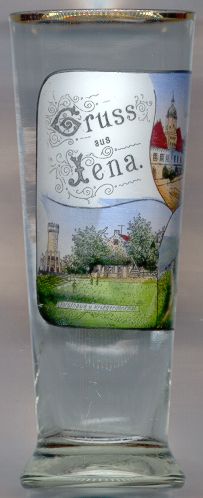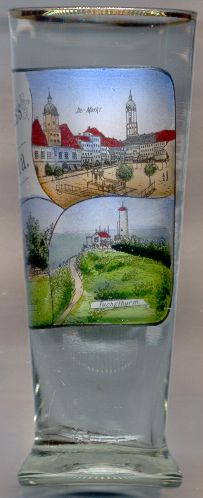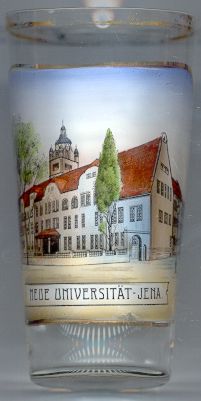

|
| DEUTSCHLAND | GERMANY |
| Bundesland: Freistaat Thüringen | Thuringia |
| Stadt: Jena |
Jena is situated at an elevation of 151 m on the river Saale in Thuringia.
Jani was first mentioned in AD 830/850 together with Liudraha (Leutra, today part of Jena).
Jena was first mentioned as a town in 1236. Around 1523/1524, Jena became one of the centres of the Reformation.
Martin Luther visited Jena several times and preached in the town church. The university of Jena (today named after Friedrich Schiller) was founded in 1558.
In 1672, Jena became the residence town of the Duchy of Saxe-Jena (see chart of the Wettin dynasty).
When the line Saxe-Jena became extinct in 1690, Jena became part of Saxe-Weimar.
Around 1800, Jena became an important cultural and intellectual centre. Among the many important personalities living in Jena at that time were
the poets Johann Wolfgang von Goethe and Friedrich Schiller,
the philosophers Johann Gottlieb Fichte, Georg Wilhelm Friedrich Hegel, Friedrich Wilhelm Joseph von Schelling and Ludwig Andreas Feuerbach,
the jurist Paul Johann Anselm Feuerbach, the geometer Karl Wilhelm Feuerbach, and the physician Christoph Wilhelm Hufeland.
In 1806, the Napoleonic troops defeated the Prussian army in two parallel battles at Jena and Auerstedt.
The later famous glass industry of Jena was introduced by Carl Zeiss in 1846.
At the end of World War II in 1945, Jena was severely damaged by several bomb raids.
After the war, large parts of the historic town centre were demolished until 1970.


The  Rathaus (town hall) [top right picture: left] was first mentioned in 1365.
The present building dates from 1377/1378 and around 1413. In 1755, the town hall was renovated and also received its
characteristic tower, which also houses the famous astronomical clock dating from the 15th century.
Rathaus (town hall) [top right picture: left] was first mentioned in 1365.
The present building dates from 1377/1378 and around 1413. In 1755, the town hall was renovated and also received its
characteristic tower, which also houses the famous astronomical clock dating from the 15th century.
The  Stadtkirche (town church) Sankt Michael [top right picture: right]
was begun in the late 14th century on the spot of two earlier Romanesque churches. The Gothic choir was built in 1380–1442,
The late Gothic nave of the hall church was completed in 1506. The church tower, built between 1474 and 1557 and topped with a
Renaissance roof (total height 72.5 m), remained in possession of the city until 1932. The church was severely damaged in 1945
and was rebuilt in simplified forms after the war. Restoration works were carried out in 1983/1984 and 1998–2001.
Stadtkirche (town church) Sankt Michael [top right picture: right]
was begun in the late 14th century on the spot of two earlier Romanesque churches. The Gothic choir was built in 1380–1442,
The late Gothic nave of the hall church was completed in 1506. The church tower, built between 1474 and 1557 and topped with a
Renaissance roof (total height 72.5 m), remained in possession of the city until 1932. The church was severely damaged in 1945
and was rebuilt in simplified forms after the war. Restoration works were carried out in 1983/1984 and 1998–2001.
The centre of the Marktplatz (market square) is marked by the
 monument
monument
The  Fuchsturm (fox tower) [bottom right picture] is the original keep of the
former castle Kirchberg, which was first mentioned in AD 937. Together with two neighbouring castles, Kirchberg was destroyed completely
during the war between the Lords of Kirchberg and the cities of Erfurt, Nordhausen and Mühlhausen.
The Fuchsturm is the only part of the castles that has remained. The first attempts to renovate the tower were made already in 1584, but it
took until the end of the 19th century that the tower came in use again as a popular lookout tower.
Fuchsturm (fox tower) [bottom right picture] is the original keep of the
former castle Kirchberg, which was first mentioned in AD 937. Together with two neighbouring castles, Kirchberg was destroyed completely
during the war between the Lords of Kirchberg and the cities of Erfurt, Nordhausen and Mühlhausen.
The Fuchsturm is the only part of the castles that has remained. The first attempts to renovate the tower were made already in 1584, but it
took until the end of the 19th century that the tower came in use again as a popular lookout tower.
The  Kriegerdenkmal (soldiers monument) [bottom left picture],
a tower commemorating the German-French war of 1870/1871, was built immediately after the end of that war.
Kriegerdenkmal (soldiers monument) [bottom left picture],
a tower commemorating the German-French war of 1870/1871, was built immediately after the end of that war.

The  Neue Universität [left],
the new university building,
was erected in 1905–1908 by the architect Theodor Fischer.
The site of the building was originally occupied by the old town castle from the 16th and 17th century.
The new university building was funded mainly by the Carl Zeiss Foundation. The complex was renovated in 1990–1993.
Neue Universität [left],
the new university building,
was erected in 1905–1908 by the architect Theodor Fischer.
The site of the building was originally occupied by the old town castle from the 16th and 17th century.
The new university building was funded mainly by the Carl Zeiss Foundation. The complex was renovated in 1990–1993.
![[scale]](lineal.jpg)